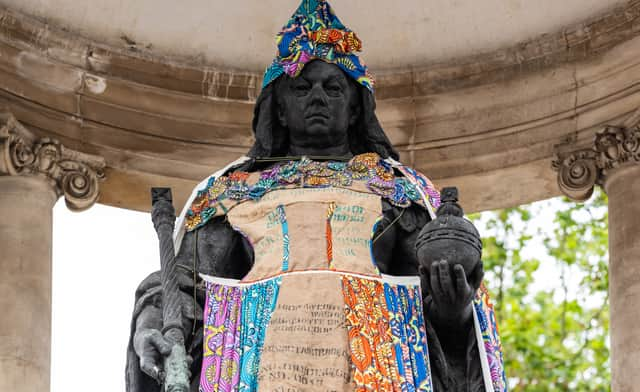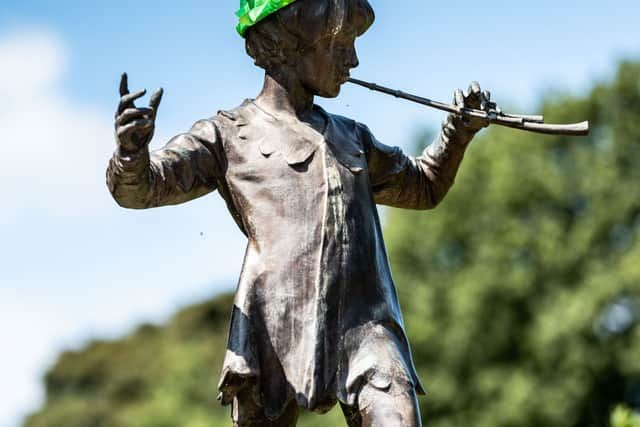Artist who made dress removed from Queen Victoria statue vows to return to Liverpool


The successful fashion designer behind the ‘Gone with the Wind’ dress mysteriously removed from The Queen Victoria statue in Derby Square has vowed to return to Liverpool in support of the city’s ongoing public art project.
London-based designer Karen Arthur, working in collaboration with historian Laurence Westgaph, created the striking garment as part of Liverpool City Council’s Culture Liverpool Very Public Art campaign.
It is currently unclear who removed the artwork.
Why was the artwork on the statue?
Advertisement
Hide AdAdvertisement
Hide AdThe dress, made of cotton and hessian, features in a Sky Arts documentary project over the summer following artists as they reimagine some of Liverpool’s most iconic statues.
The project’s creators said the piece was made to reflect on Liverpool’s complicity with slavery and how Queen Victoria and Britain were beneficiaries as recently as 150 years ago.
They added that during Queen Victoria’s reign, cotton played a crucial part in Liverpool’s trading activities and the wider economic success of Britain, but up until the American Civil War in the 1860s, this cotton was being picked by enslaved people in the United States.
An additional satin patchwork cloak paid homage to a handmade quilt gifted to Queen Victoria by Martha Ricks, a black woman who travelled from Liberia to meet her.
Reaction to the installations
Advertisement
Hide AdAdvertisement
Hide AdGB News presenter and former UKIP leader Nigel Farage has caused controversy by responding to the arts project stating that he is “tired of the endless conversation about the UK’s complicity with slavery.”
Designer Arthur, who makes bespoke handmade clothing for women, working mostly with colourful African prints, took to social media to air her views about the dress being removed from the early 20th century Queen Victoria statue.
She said she had discussed what had happened with those close to her and wrote: “We have memories [from the art project], an incredible experience with my daughter and history made.”
Ms Arthur, who received a number of supportive comments on her Instagram account, revealed the cloak was safe as it was removed for filming for “public safety reasons” so they still had something “tangible” left of the work.


Advertisement
Hide AdAdvertisement
Hide AdShe added: “I had planned to revisit Liverpool in a couple of weeks to have a look at the other incredible statues redressed by so many amazing artists and to see [the] Queen Victoria statue dressed for a final time.
“I booked the same gorgeous hotel and I’m going to take myself on a solo dinner date to celebrate a remarkable achievement.
“I’m totally still going…we must honour ourselves intentionally more often. I deserve this.”
Director of Sky Arts Philip Edgar-Jones said: ‘We can confirm that the artwork placed upon the Queen Victoria monument has been removed during its time in position.
Advertisement
Hide AdAdvertisement
Hide Ad“This is the kind of thing we might expect from a project that addresses the conversation around statues and who or what we commemorate in our towns and cities. The project continues to grow and more statues are being redressed today and over the coming weeks.”
Other works across Liverpool
Redressing the statues is also part of the city council’s Very Public Art campaign.
It includes a giant bronze statue of former British prime minister William Gladstone in St John’s Gardens wrapped in a pan-African flag by artist Larry Achiampong.
The flag features 54 stars that represent the 54 countries of Africa, and its green, black and red colours reflect, respectively, its land, its people and the struggles the continent has endured. The yellow background represents a new day and prosperity.
Advertisement
Hide AdAdvertisement
Hide AdIt is located in the graveyard where enslaved people in Liverpool were buried.


What other Redressed installations can you see?
Eleanor Rigby in Stanley Street and Peter Pan in Sefton Park are the latest statues to be ‘redressed’.
The project will see 20 artists place their work on 50 statues in all, but more upcoming installs for this summer are as yet “under wraps”.
A two-hour documentary special, Statues Redressed, will be broadcast on Sky Arts and the streaming service NOW in October.
Comment Guidelines
National World encourages reader discussion on our stories. User feedback, insights and back-and-forth exchanges add a rich layer of context to reporting. Please review our Community Guidelines before commenting.